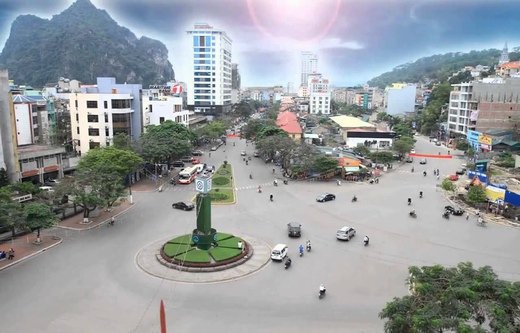Halong city

Halong city is one of the fastest developing cities in north east Vietnam. Ha Long City is not likely
to win prizes for its architecture or facilities, but it
is by no means the hell-hole portrayed in the -Lonely
Planet- travel guide.
The city is the provincial capital of Quang Ninh
province, and was created in the nineties by
amalgamating Bai Chay, a tourist area, with the much
larger industrial and commercial area of Hong Gai. The
considerable differences between the two elements, and
their separation by a busy vehicle ferry crossing the
Cua Luc estuary, made them uneasy bedfellows at first,
but time and the imminent construction of a bridge is
bringing them together.
Surprisingly, the tourist area of Bai Chai is the less
attractive area for the serious traveller. Ha Long City's
market The long seafront suffers from uncontrolled and
inappropriate development, and apart from the hotels,
restaurants and souvenir shops (mostly poor quality),
and the Royal Park, a long seafront development with few
distinctive attractions, there is little reason to spend
much time there. Almost invariably, we recommend our
clients to spend the night on a
well-equipped boat on Ha
Long Bay
Of course, Ha Long City-s fame is its location facing
the World Heritage Area of
Ha Long Bay. The main access
point is a purpose built wharf to the west of Bai Chay.
Its location means that the large numbers of day-trip
visitors by-pass Ha Long City altogether, thus depriving
the local community of much-needed income. If time
permits, a visit to Hong Gai is worthwhile.
Coal dust is mixed with clay to make the waste into a
usable fuel. Although some of the coal mines and
associated heavy industries have been moved further
east, the commercial nature of Hong Gai is immediately
evident.
Unlike Bai Chay, there has been no attempt to
-internationalise- Hong Gai. Nearly all the buildings
are comparatively new: almost the entire area was
flattened by blanket bombing during the war.
Fortunately, a small area in the south of Hong Gai
escaped the destruction. In its centre is Bai Tho
(-Poem-) Mountain, the name derived from the several
verses carved into its almost Long Tien pagoda nestles
at the base of Poem Mountain vertical seaward face by
famous kings and poets. The limestone peak is
unexpectedly rich in bio-diversity and offers stunning
views of the bay and the red backs of sea eagles
swooping below.
It's also steeped in Vietnamese culture, not only for
its role in wars and conflicts through the ages, but
also for its religious associations. Two attractive
temples, one on each side of the mountain, are worth a
visit.
Elsewhere, Hong Gai bustles with life, and is a good
example of Vietnam-s emerging industrial cities. A
stroll around the market and port is pleasant and
informative.
Ha Long City is already growing rapidly. However, it-s
inevitable that the rate of growth will accelerate as it
lies upon the main road to southern China. At present,
the heavy lorries have to use the ferry - once the
bridge is built, and the road to the border gate is
upgraded, goods traffic will escalate.
The original fishermen's wharf, now swept away by a tide
of 'modernisation' The 160km journey to Ha Long City
takes about 2- hrs. Nearly all accommodation is in Bai
Chay. At present, there are five good quality hotels
but, although comfortable, none is up to deluxe
standard. There is a limited number of reasonable
mid-range hotels and an abundance of budget
accommodation, much of it poor quality.
Restaurant menus are quite limited, but the seafood is
excellent, especially that served on the boats we use. A
good alternative is the floating restaurant near Bai Tho
mountain. Apart from the ubiquitous karaoke
establishments and various shows and entertainment in
the Royal Park, there-s not much to do in the evenings
apart from strolling among the prom or around Hong Gai.
On the western outskirts of the city, Tuan Chau is a
small soil island close to the mainland that has been
converted to a large resort area. Although well done,
and boasting some of the best accommodation in Ha Long
City, it has been designed to attract Vietnamese and
Chinese visitors and is unlikely to appeal to those from
developed countries elsewhere.
 Read more
Read more












